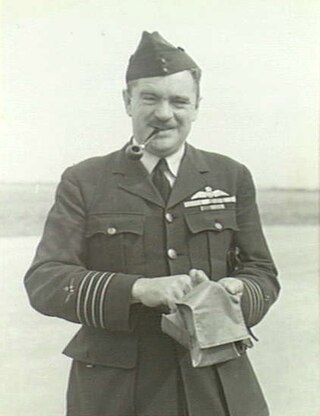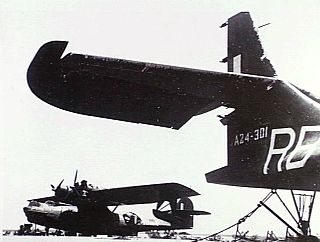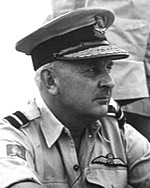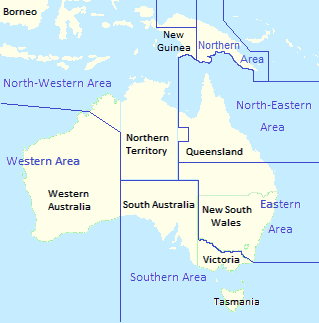
No. 12 Squadron was a Royal Australian Air Force (RAAF) general purpose, bomber and transport squadron. The squadron was formed in 1939 and saw combat in the South West Pacific theatre of World War II. From 1941 to 1943, it mainly conducted maritime patrols off northern Australia. The squadron was based at Merauke in western New Guinea from November 1943 to July 1944, when it was withdrawn from operations. After being re-equipped, it operated as a heavy bomber unit from February 1945 until the end of the war. The squadron continued in this role until it was redesignated No. 1 Squadron RAAF in February 1948. The squadron was reformed in 1973 to operate transport helicopters but was again disbanded in 1989.

No. 84 Wing is a Royal Australian Air Force (RAAF) transport wing. Coming under the control of Air Mobility Group (AMG), it is headquartered at RAAF Base Richmond, New South Wales. The wing comprises No. 35 Squadron, operating Aliena C-27J Spartan transport Aircraft; No. 37 Squadron, operating Lockheed Martin C-130J Super Hercules medium transports; and a technical training unit, No. 285 Squadron.

No. 78 Wing is a Royal Australian Air Force (RAAF) operational training wing, headquartered at RAAF Base Williamtown, New South Wales. It comprises Nos. 76 and 79 Squadrons, operating the BAE Hawk 127 lead-in fighter, and No. 278 Squadron, a technical training unit. No. 79 Squadron, located at RAAF Base Pearce, Western Australia, is responsible for converting new pilots to fast jets, while No. 76 Squadron at Williamtown conducts introductory fighter courses; both units also fly support missions for the Royal Australian Navy and the Australian Army.

North-Eastern Area Command was one of several geographically based commands raised by the Royal Australian Air Force (RAAF) during World War II. For most of its existence it controlled units based in central and northern Queensland as well as Papua New Guinea. It was formed in January 1942 from the eastern part of the former Northern Area Command, which had covered all of northern Australia and Papua. Headquartered at Townsville, Queensland, North-Eastern Area Command's responsibilities included air defence, aerial reconnaissance and protection of the sea lanes within its territory. Its flying units, equipped with fighters, reconnaissance bombers, dive bombers and transports, took part in the battles of Rabaul, Port Moresby and Milne Bay in 1942, and the landings at Hollandia and Aitape in 1944.

No. 71 Squadron was a Royal Australian Air Force (RAAF) maritime patrol squadron of World War II. It was formed in January 1943 and conducted patrols off the east coast of Australia until it was disbanded in August 1944.

Air Commodore Francis William Fellowes (Frank) Lukis, CBE was a senior commander in the Royal Australian Air Force (RAAF). A veteran of World War I, he first saw combat as a soldier in the Australian Imperial Force at Gallipoli. In 1917, Lukis transferred to the Australian Flying Corps and flew with No. 1 Squadron in the Middle East, where he was twice mentioned in despatches. A member of the Australian Air Corps following the war, he transferred to the fledgling RAAF in 1921, and became the first commanding officer of the newly re-formed No. 3 Squadron at RAAF Station Richmond, New South Wales, in 1925.

Air Vice Marshal Allan Leslie Walters, CB, CBE, AFC was a senior commander in the Royal Australian Air Force (RAAF). Born in Victoria and raised in Western Australia, he graduated from the Royal Military College, Duntroon, before transferring to the RAAF in 1928. He was one of the service's leading flying instructors and aerobatic pilots between the wars, and was appointed to his first squadron command in 1937. Over the course of World War II, Walters led No. 1 Squadron in Singapore, No. 1 (Fighter) Wing in Darwin, Northern Territory, No. 72 Wing in Dutch New Guinea, and Northern Command in Papua New Guinea. He was decorated with the Air Force Cross in 1941 for his work with No. 1 Squadron, and mentioned in despatches in 1944 for his service with No. 72 Wing.

No. 73 Wing was a Royal Australian Air Force (RAAF) wing of World War II. It was formed in February 1943 at Port Moresby, Papua New Guinea, as part of No. 9 Operational Group. The wing initially comprised three attack squadrons flying CAC Wirraways, Douglas Bostons, and Bristol Beaufighters, with which it took part in the New Guinea campaign until mid-year. It was then reorganised with three fighter squadrons operating P-40 Kittyhawks and Supermarine Spitfires; in this form it saw action in the New Britain and Admiralty Islands campaigns through 1943–44. The wing was disbanded at Los Negros in August 1944, and by the beginning of 1945 its squadrons had been absorbed into other RAAF wings under No. 10 Operational Group.

No. 76 Wing was a Royal Australian Air Force (RAAF) wing that operated during World War II. Initially based in Far North Queensland, its headquarters transferred to Darwin, Northern Territory, in September 1944 to take control of three PBY Catalina units: Nos. 20, 42, and 43 Squadrons. The prime task of these squadrons was minelaying in the South West Pacific theatre, and they conducted these operations as far afield as Java, Borneo, the Philippines, and China. As well as minelaying, No. 76 Wing's Catalinas flew bombing, patrol, and transport missions, and dropped millions of propaganda leaflets in the closing months of the war. The wing headquarters disbanded in November 1945.

No. 72 Wing was a Royal Australian Air Force (RAAF) wing that operated during World War II. It was formed in April 1943 at Townsville, Queensland, as part of North-Eastern Area Command. Led by Group Captain Charles Eaton, the wing soon deployed to Merauke, Dutch New Guinea, where it comprised three squadrons flying CAC Boomerang and P-40 Kittyhawk fighters, and A-31 Vengeance dive bombers. Eaton was succeeded by Group Captain Allan Walters in mid-1943. No. 72 Wing took part in the defence of Torres Strait, undertaking interception, patrol and occasional ground-attack and anti-shipping duties. By July 1944, its original squadrons had all been disbanded or transferred to other operational formations. No. 120 Squadron, which had arrived in May 1944, operating Kittyhawks, remained at Merauke until February 1945. The wing headquarters returned to Australia that May, and disbanded the following month.

RAAF Command was the main operational arm of the Royal Australian Air Force (RAAF) during World War II. The command was formed in September 1942 and by April 1943 comprised 27 squadrons, including units from the Netherlands, the United Kingdom and the United States, as well as Australia. Coming under the operational authority of Allied Air Forces Headquarters in the South West Pacific Area, RAAF Command exercised control of its units through geographically based area commands in Australia and, later, New Guinea, as well as large mobile formations including the Australian First Tactical Air Force. The command reached a strength of 41 squadrons in October 1944. From the time of its establishment, until its disbandment in September 1945, it was led by Air Vice Marshal Bill Bostock.

Air Vice Marshal Alan Moorehouse Charlesworth, CBE, AFC was a senior commander in the Royal Australian Air Force (RAAF). Born in Tasmania, he graduated from the Royal Military College, Duntroon, and served with the 2nd Light Horse Regiment in Queensland before transferring to the Air Force in 1925. Most of his pre-war flying career was spent with No. 1 Squadron at RAAF Station Laverton, Victoria. In 1932 he undertook a series of survey flights around Australia, earning the Air Force Cross. Charlesworth's early wartime commands included No. 2 Squadron at Laverton, and RAAF Station Pearce in Western Australia. Appointed Air Officer Commanding (AOC) Eastern Area in December 1943, he was promoted temporary air commodore the following year and took over as AOC North-Western Area in Darwin, Northern Territory.

Northern Area Command was one of several geographically based commands raised by the Royal Australian Air Force (RAAF) during World War II. It was formed in May 1941, and covered northern Australia and Papua. Headquartered at Townsville, Queensland, Northern Area Command was responsible for air defence, aerial reconnaissance and protection of the sea lanes within its boundaries. In January 1942, following the outbreak of the Pacific War, it was divided into North-Western and North-Eastern Area Commands, to counter Japanese threats to northern Australia and Papua, respectively.

Northern Command was one of several geographically based commands raised by the Royal Australian Air Force (RAAF) during World War II. Established in April 1944, it evolved from No. 9 Operational Group, which had been the RAAF's primary mobile formation in the South West Pacific theatre since September 1942, but had lately become a garrison force in New Guinea. Northern Command was headquartered initially at Milne Bay and then, from August 1944, in Madang. It conducted operations in New Guinea, New Britain, and Bougainville until the end of the war. Re-designated Northern Area in December 1945, it was headquartered in Port Moresby from March 1946 and disbanded in February 1947.

Central Area Command was one of several geographically based commands raised by the Royal Australian Air Force (RAAF) during World War II. It was formed in March 1940, and covered the central portion of New South Wales. Headquartered at Sydney, Central Area Command was responsible for air defence, aerial reconnaissance and protection of the sea lanes within its boundaries. It was disbanded in August 1941 and control of its units taken over by other RAAF formations. Proposals in 1943–44 to raise a new Central Area Command did not come to fruition.

Western Area Command was one of several geographically based commands raised by the Royal Australian Air Force (RAAF) during World War II. It was formed in January 1941, and controlled RAAF units located in Western Australia. Headquartered in Perth, Western Area Command was responsible for air defence, aerial reconnaissance and protection of the sea lanes within its boundaries. Its aircraft conducted anti-submarine operations throughout the war, and attacked targets in the Dutch East Indies during the Borneo campaign in 1945.

Area commands were the major operational and administrative formations of the Royal Australian Air Force (RAAF) between 1940 and 1954. Established in response to the outbreak of World War II, they underpinned the Air Force's geographically based command-and-control system for the duration of the conflict and into the early years of the Cold War, until being superseded by a functional control system made up of Home, Training, and Maintenance Commands.

Southern Area Command was one of several geographically based commands raised by the Royal Australian Air Force (RAAF) during World War II. It was formed in March 1940, and initially controlled units located in Victoria, Tasmania, South Australia and southern New South Wales. Headquartered in Melbourne, Southern Area Command was responsible for air defence, aerial reconnaissance and protection of the sea lanes within its boundaries. From 1942 its operational responsibilities excluded New South Wales.

North-Western Area Command was one of several geographically based commands raised by the Royal Australian Air Force (RAAF) during World War II. Its wartime sphere of operations included the Northern Territory, adjacent portions of Queensland and Western Australia, and the Dutch East Indies. The command was formed in January 1942, following the outbreak of the Pacific War, from the western part of Northern Area Command, which had covered all of northern Australia and Papua. Headquartered at Darwin, North-Western Area Command was initially responsible for air defence, aerial reconnaissance and protection of the sea lanes within its boundaries.

No. 75 Wing was a Royal Australian Air Force (RAAF) wing that operated during World War II. It was formed in October 1943 at Townsville, Queensland, under North-Eastern Area Command. The wing soon deployed to Horn Island to take control of RAAF units based there and at Thursday Island and Cape York Peninsula. Responsible for air defence and maritime patrol in the Torres Strait, No. 75 Wing's flying units operated P-40 Kittyhawk fighters, Bristol Beaufort reconnaissance bombers, and A-31 Vengeance dive bombers. The wing was disbanded in August 1944.



















